Finding the Best Digital Delay Pedal in 6 Simple Steps – 2018 Update
When I found out about the great effects I could create using a delay pedal, I knew I had to buy one. I searched tirelessly for the best digital delay pedal but was overwhelmed by how many products there were. Now, I’m here to make your search a little easier. Let’s take a look at some of my favorites.
Best Digital Delay Pedal | Our Rating | Price |
|---|---|---|
$$$ | ||
$$$ | ||
$ | ||
$$ | ||
$ |
**You'll find detailed comparison below, but you can also check the prices or read Amazon Customer Reviews by click the links above.
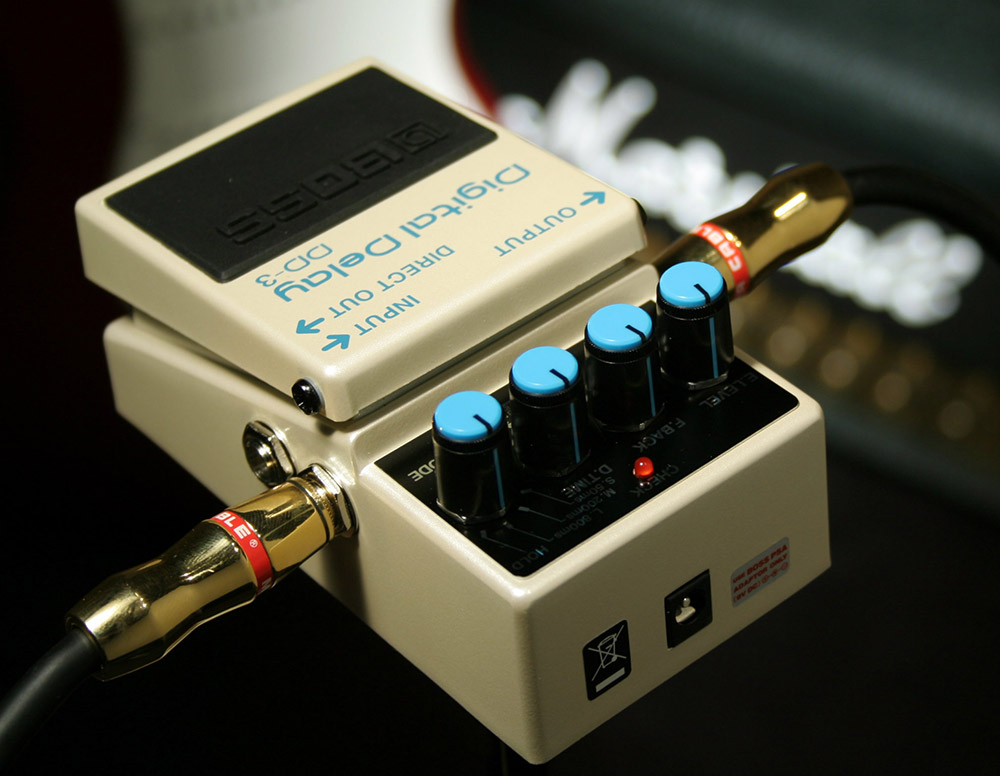
Boss DD-3 Digital Delay Pedal - Source: zzounds.com
Finding the Best Pedal
How to Choose
My favorite thing about delay pedals is their ability to create such a wide variety of reverberant echo effects. These pedals are a great investment, but some musicians find digital delays don’t have the same charm as older analog models. Investing in a digital model that has a high sound quality and an analog setting is a great way to deal with this issue.
These pedals also have longer delay times, so instead of looking for the best analog delay pedals, it might be a good idea to research some digital models first. Delay pedals can be incorporated into almost any style of music, so they’re extremely versatile. Before you go out and purchase a delay pedal, make sure you ask consider:
- How much you’re willing to spend
- The features and tone you want your delay pedal to have.
Typically, even if you purchase the best cheap delay pedal, you’re not going to get the same quality as a high end pedal. While it’s important to stick to any budget restrictions you may have, it’s also important to remember that a little bit of wiggle room can open up a lot of sound opportunities.
I’ll be sure to include digital delay pedals of a range of different prices, so you’ll be able to find a good model no matter what you’re willing to spend.
You’ll also want to keep in mind how many features you’re looking for and what kind of tone you want your pedal to produce. Usually, lower end pedals will have very few features, and more expensive pedals will have a wide array of sound effects you can experiment with.
Additionally, some delays will have warm, grainy sounds, and others will have cleaner sound. For some extra information on how to use a delay pedal, follow this link.
Advantages of a Digital Delay Pedal
A digital delay pedal is a great investment because of its ability to create more depth in a musicians tone and create more of an intimate atmosphere.
These pedals will allow you to create echo effects by adjusting the time between repeats, as well as how many repeats are heard.
With a digital delay pedal, you won’t hear a gradual degradation of sound quality as the repeats are heard, like some analog delay pedal models.
These pedals also often more delay time, memory space, and unique delay effects such as “reverse”, which will play your audio back to you in reverse order.
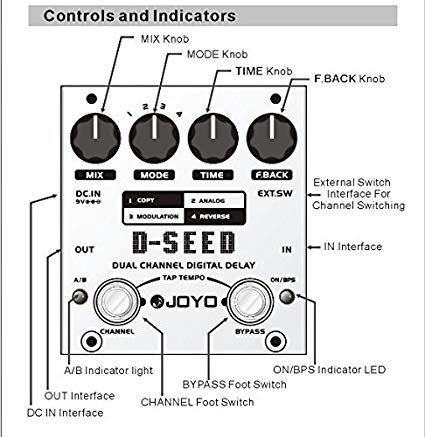
JOYO D-SEED Dual Channel Digital Delay Guitar Effect Pedal with Four Modes - Source: amazon.com
Things to Look For
When you’re preparing to buy a digital delay pedal, there are a number of things to look for. My first suggestion is to always stick with brand names that you trust. If you buy from companies with poor reputations, you might be disappointed with the sound quality of your device. If you want to determine whether a company is reliable, try doing the following:
- Watch many different YouTube reviews of their products
- Check for a warranty
By watching a lot of reviews of the products you’re thinking about purchasing, you’ll have a much better idea of whether other musicians feel that the pedals perform the way the company says they will perform. Often, YouTube reviews will also include demonstrations of the pedal being used with an instrument, which will help you decide whether you like that pedal’s tone.
Additionally, try checking for a warranty on the product. If a company doesn’t offer a warranty, it probably means they aren’t confident about the device lasting a long period of time.
The Best Way to Use a Delay Pedal
From my experience, the best way to use a digital delay pedal is in at the end of a pedal chain following your modulation pedals. Typically, it’s better to produce the sound effects you want with your other pedals first, and then make those sound effects more reverberant with a delay pedal. For more information on how to set up a pedal chain, take a look at this article.
Review
1. Boss DD-7 Digital Delay Pedal
This is a great pedal for musicians who are looking for durability and great sound quality. This pedal comes with a Delay Time knob, a Feedback knob, and E. Level knob, and a Mode knob. Your time knob will allow you to adjust the time that will elapse between each repeat, and your feedback knob will allow you to choose how many repeats you hear.
Once you’re happy with these settings, you can use the E. Level knob to adjust the volume. The mode knob on this pedal comes with eight settings, including four basic time settings (50 ms, 200 ms, 800 ms, and 3200 ms), as well as a hold setting, a modulation setting, an analog setting, and a reverse setting.
The analog setting on this pedal will make it a great fit for musicians who are seeking a vintage rock and roll style sound. The modulation setting on this model will let you experiment with chorus style effects that slightly alter the timing and pitch to mimic a human choir. If you want to hear both of these effects, take a look at this great demo video.
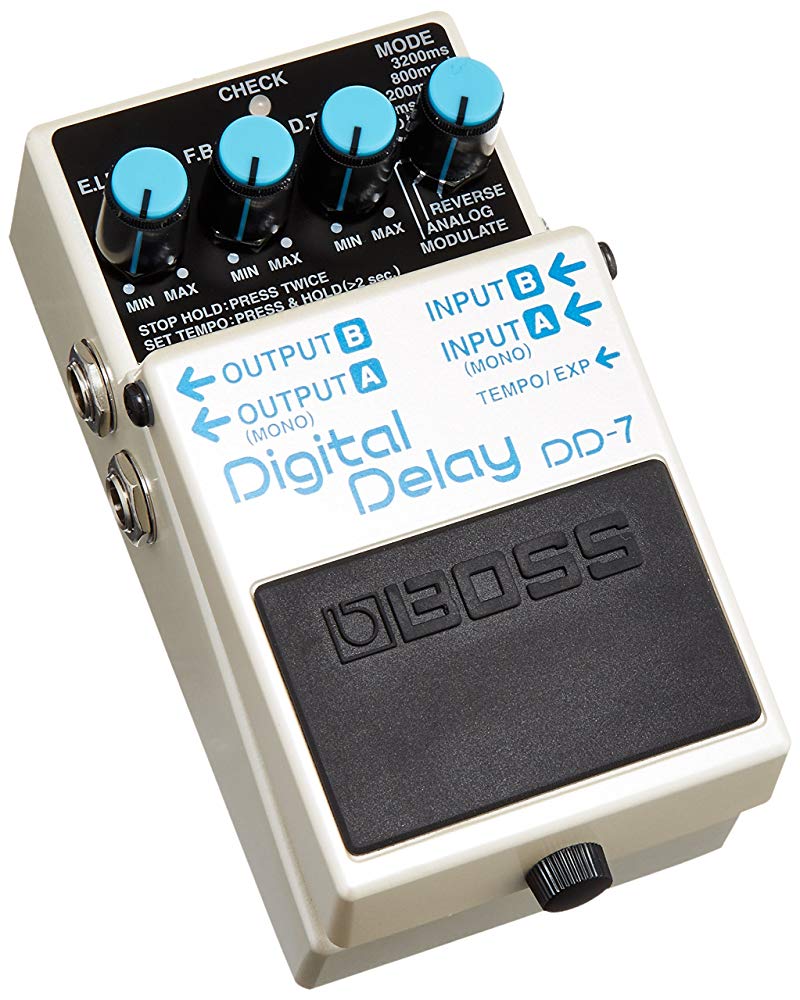
Source: Amazon.com
Editor Rating:
Pros
- Modulation mode
- Analog Mode
- Durable
Cons
- Expensive
- Less delay time than large Boss models
- Takes up more space on pedalboard than mini models
2. Boss DD-3 Digital Pedal
This model is the predecessor of the DD-7 model, so you can expect similar quality but fewer features. The DD-3 has been a favorite among guitarists since it first appeared on the market in 1986.
Many musicians say this pedal is better at maintaining the true tones of a guitar than the DD-7. Try listening to the difference between these two pedals to make your decision. This pedal’s mode knob will give you three time options (50 ms, 200 ms, 800 ms) all in addition to a hold setting.
As you might have noticed, the delay times on this pedal are significantly shorter than the delay times possible when using a DD-7, so if you’re looking for a dramatic echo effect, you might want to choose another model.
The hold setting on this pedal will allow you to create a loop, which is great for musicians who like to stack harmonies and improvise.
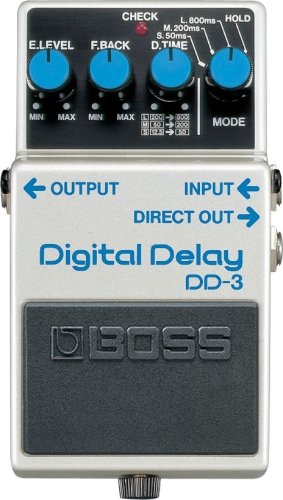
Source: Amazon.com
Editor Rating:
Pros
- Analog sound
- User friendly
- Durable material
Cons
- No modulation feature
- No reverse feature
- Less delay time than DD-7
3. Joyo JF-08 Digital Delay Effect Pedal
The Joyo JF-08 pedal is an excellent option for musicians who are on a budget and find the Boss models above too expensive. Many users of this pedal are surprised at how great the sound quality is considering its affordable price.
This pedal will have three knobs: Time, Repeat, and Level. The repeat knob will complete the same function as a feedback knob on other pedals does, allowing you to predetermine how many echoes you’ll hear.
For a large cave-like effect, you’ll probably want to turn this knob to its upper settings so you’ll hear a lot of echoes. For a less reverberant sound, such as the sound you’d hear if you were playing in a room with concrete walls, you’ll want to stick to the lower end of the repeat settings.
This pedal will provide you with up to 600 ms of delay time, which is shorter than the DD-3 and the DD-7 pedals. For this reason, the JF-08 pedal will work best for you if you aren’t trying to produce a dramatic effect.

Source: Amazon.com
Editor Rating:
Short delay times work well to thicken tone rather than create the illusion of playing in a concert hall, for example. If you’d like to hear this pedal in action, follow this link.
Pros
- Affordable
- Durable material
- Lightweight (0.46 KG)
Cons
- Short delay time
- No modulation setting
- No reverse setting
4. Joyo D-Seed Dual Channel Digital Delay Guitar Effect Pedal with Four Modes
The Joyo D-Seed model is another great options for musicians who are on a budget. This pedal has four knobs: a mix, time, mode, and feedback knob. The mode knob will let you choose between four great settings, including copy, analog, modulation, or reverse.
If you’re searching for a warmer analog sound than many digital delays offer, but don’t want to invest in the DD-3, this pedal will be a great option for you.
Similar to the DD-7 pedal, the Joyo D-Seed has a modulation and reverse setting, both of which will allow you to experiment with less traditional delay sounds than are heard on the Boss DD-3 pedal.
If you want to affect how wet or dry your signal is, you can use the mix knob. If you’re new to effect levels, wet and dry signals refer to how close your sound is to the natural tones of the guitar.

Source: Amazon.com
Editor Rating:
If your sound it 100% wet, then it has been completely colored with the effect, whereas if it’s 100% dry, there’s no effect at all. This pedal also has a tap tempo setting, which is excellent for musicians who want to set their delay time without adjusting the knobs. Check out this demo video to hear the different modes.
Pros
- Affordable
- Dual channel
- Durable materials
Cons
- Shorter delay time than larger models
- Lower quality than DD-7
- Is not battery-powered
5. Mooer Reecho Digital Delay Pedal
Last but not least, the Mooer Reecho delay pedal is an excellent option for musicians who want something simple to use. This pedal has only three knobs: a time knob, feedback knob, and level knob that you can use to adjust the volume. One great thing about this pedal is the small size.
If you’re looking for a device that will fit well on a crowded pedalboard, the Mooer Reecho pedal might be a good fit for you. This pedal also has a switch at the top that will allow you to choose between three modes: analog, real echo, and tape echo.
This means you’ll be able to create sounds that mimic the quality of pedals from the classic rock era. If you’re a vintage pedal enthusiast who isn’t looking for a modern digital delay sound, check out this video of the pedal in action to see if it’s right for you. This pedal is also very light, at only 0.36 pounds, which will make it a good fit for traveling musicians.
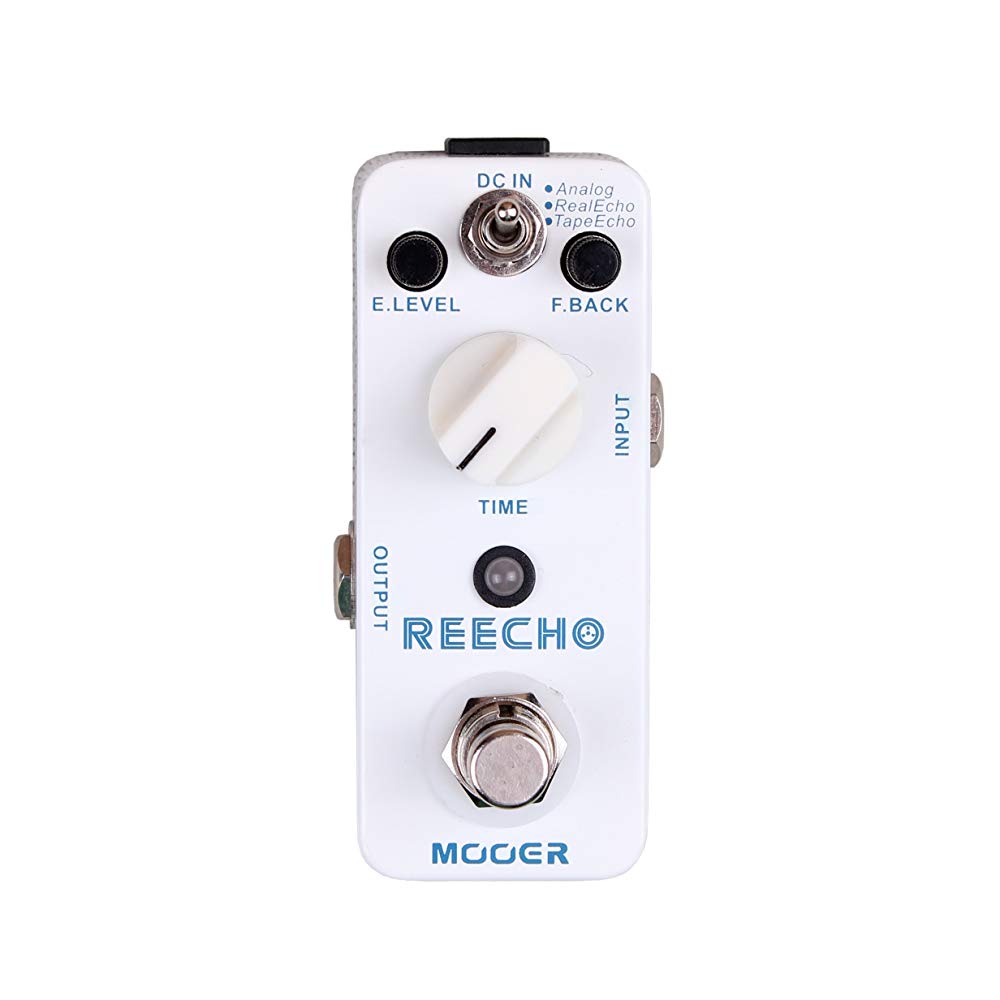
Source: Amazon.com
Editor Rating:
Pros
- Small size (fits well on pedalboard)
- Easy to use
- Affordable
Cons
- Small knobs
- No modulation setting
- No reverse setting
In Sum
Hopefully, this review on the best digital delay pedal models helped you make your decision. Delay pedals are an excellent way to add depth to your tone through reverberant echoes. This can lead to creating a much more intimate atmosphere or the illusion of being inside a massive cave.
In my opinion, the best delay pedal for guitar is the Boss DD-7 pedal because of it’s high sound quality and numerous delay effects. This pedal will last you for years to come and will provide countless options for experimentation. However, I love all of these models, so pick what works for you and enjoy!
Featured image source: worshipmusician.com
